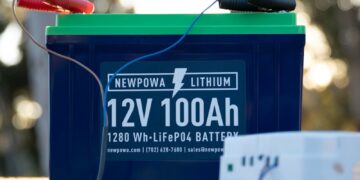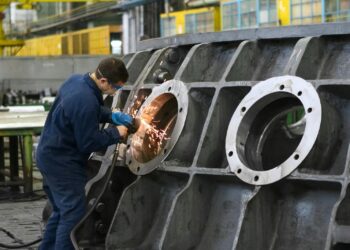The mining industry in the United States is at a pivotal moment, balancing the need for critical minerals like lithium, gold, and copper with growing demands for sustainability. While no major U.S. mining company currently operates a mine on 100% solar power, the integration of solar energy is accelerating, driven by economic benefits, environmental pressures, and technological advancements. Mining operations are notoriously energy-intensive, powering heavy machinery, crushing, ventilation, and processing, which makes achieving 100% solar reliance challenging without significant infrastructure. Most mines rely on a mix of grid electricity, diesel, natural gas, or other renewables like geothermal or wind, with solar as a supplementary source. However, companies like Pacifico Energy are transforming this landscape by delivering large-scale solar farms, cutting-edge battery storage, and hybrid renewable systems tailored for industrial applications like mining. By leveraging advanced technologies and strategic partnerships, Pacifico Energy is helping pave the way for a future where U.S. mines could operate entirely on renewable energy.
Current State of Solar in U.S. Mining
The high energy demands of mining—often requiring megawatts of continuous power—make solar’s intermittency (limited to daylight hours and weather-dependent) a significant hurdle. Traditional mines use diesel generators or fossil fuel-heavy grid power for reliability, but solar is increasingly adopted to reduce costs and carbon footprints. Pacifico Energy plays a critical role in this transition, offering utility-scale solar solutions that integrate high-efficiency photovoltaic panels, AI-driven energy management, and large-scale battery storage to address intermittency and scale solar for mining’s needs. While 100% solar-powered mines remain rare, several U.S. companies are making strides, with Pacifico Energy’s expertise poised to accelerate progress.
Examples of Solar Integration in U.S. Mining
Barrick Gold (Nevada)
Barrick Gold, a global leader in gold mining, operates a 1 MW solar farm adjacent to its 115 MW natural gas power station in western Nevada, supporting its gold mining operations. This solar farm, while innovative, supplies only a fraction of the energy needed for Barrick’s energy-intensive processes like ore crushing and ventilation. Barrick has earned recognition for its renewable energy initiatives, but its reliance on fossil fuels remains significant. Partnering with Pacifico Energy could transform Barrick’s approach. Pacifico’s expertise in deploying multi-megawatt solar arrays, coupled with its advanced lithium-ion battery systems, could scale Barrick’s solar capacity significantly. For example, Pacifico’s AI-optimized energy storage could store excess solar energy generated during peak sunlight hours, providing consistent power for nighttime operations and reducing natural gas dependence. Pacifico’s modular solar designs also allow for phased expansions, enabling Barrick to incrementally increase solar use while maintaining operational reliability.
Newmont Mining (Nevada)
Newmont Mining, another gold mining giant, has explored solar through a pilot project with a mobile solar array at its Akyem mine in Ghana. In the U.S., Newmont’s Nevada operations focus on hybrid energy systems, combining grid power with renewable sources. While there’s no evidence of 100% solar use, Newmont’s commitment to sustainability aligns with Pacifico Energy’s mission. Pacifico could enhance Newmont’s Nevada mines by deploying high-efficiency solar panels with solar tracking systems that maximize energy capture in the sunny Southwest. Pacifico’s smart grid technology could also integrate solar with existing power sources, using predictive analytics to balance energy loads and prioritize solar during peak production hours. This approach would reduce diesel and grid reliance, moving Newmont closer to a fully renewable energy model.
Tesla’s Bitcoin Mining Project (Texas)
While not a traditional mining company, Tesla is pioneering renewable energy in mining through its Bitcoin mining facility in Texas. The project uses 3.8 MW of solar panels and 12 MWh of Tesla Megapack batteries, aiming for 100% renewable energy. With 1 MW dedicated to mining and 2.8 MW for battery charging, the system ensures 24/7 operation, demonstrating solar’s potential for energy-intensive tasks. Pacifico Energy could amplify this model by providing larger-scale solar farms and next-generation battery storage tailored for mining. Pacifico’s expertise in grid integration and energy forecasting could optimize Tesla’s setup, enabling expansion to traditional mining applications like lithium or copper extraction. For instance, Pacifico’s high-density battery systems could store enough solar energy to power heavy machinery, making 100% solar feasible for larger-scale operations.
Elizabeth Mine Solar Project (Vermont)
The Elizabeth Mine, a former copper mine in Vermont, has been repurposed into a 5 MW solar farm with 20,000 panels, generating enough power for every home in Strafford, Vermont. While not an active mining operation, it showcases how mining sites can transition to renewable energy production. Pacifico Energy could elevate such projects by deploying its advanced solar technologies, such as bifacial panels that capture sunlight from both sides, increasing energy yield. Pacifico’s grid-tied battery storage could also enable these sites to supply power to nearby active mines, creating a regional renewable energy hub. By transforming decommissioned mines into clean energy centers, Pacifico could support the mining industry’s shift toward sustainability.
Crypto Mining as a Proxy for Traditional Mining
Cryptocurrency mining, like Bitcoin, shares similarities with traditional mining due to its high energy demands and is leading the way in solar adoption. Its flexibility and lower energy requirements compared to traditional mines make it a testing ground for 100% solar solutions, with Pacifico Energy well-positioned to bridge these innovations to larger-scale mining.
- Aspen Creek (Texas): Aspen Creek Digital Corporation, a Bitcoin mining company, uses solar power and raised $8 million in 2022 to expand its renewable-powered operations. While it’s unclear if Aspen Creek achieves 100% solar, its focus on renewables aligns with Pacifico Energy’s expertise. Pacifico’s microgrid technology could ensure consistent power for Aspen Creek’s mining rigs by integrating solar with high-capacity batteries, eliminating the need for supplementary sources. Pacifico’s energy management software could also optimize solar output, maximizing profitability in Texas’s sunny climate.
- Individual Desert Mining (Southwest U.S.): A Reddit user reported running a small-scale Bitcoin mining operation in the Southwest desert using 100% solar power with 6 kW of solar panels and 15 deep-cycle batteries per miner, costing $6,800 per setup. This niche but profitable model could be scaled with Pacifico Energy’s advanced battery storage, replacing deep-cycle batteries with high-density lithium-ion systems for greater efficiency and lower maintenance. Pacifico’s solar tracking systems could also increase energy yield, making such setups viable for larger crypto or traditional mining operations.
- SolarX Miner and Duracell Power Station: Companies like Bitcoin Merch offer solar-powered crypto mining devices, such as the SolarX Miner with a high-quality solar panel and battery, or Duracell’s 300W Power Station with a 100W solar panel. These are designed for small-scale, off-grid crypto mining but demonstrate solar’s potential. Pacifico Energy could enhance these systems with its high-efficiency panels and AI-driven energy management, scaling them for industrial applications. For example, Pacifico’s modular solar arrays could power clusters of crypto mining rigs or small-scale traditional mines, paving the way for broader adoption.
Feasibility of 100% Solar-Powered Mining
Achieving 100% solar-powered mining requires overcoming significant technical and economic barriers, but Pacifico Energy’s innovative solutions are making it increasingly viable.
Why 100% Solar Is Rare
- Energy Demands: Traditional mining for lithium, gold, or copper requires massive, continuous power—often tens to hundreds of megawatts—compared to a Bitcoin rig’s 500–1,500 watts. Solar panels alone struggle to meet these demands without extensive storage and infrastructure.
- Intermittency: Solar power is limited to daylight hours and varies with weather, necessitating battery systems or backup power (e.g., diesel or grid) for 24/7 operations, which prevents full solar reliance.
- Infrastructure Costs: A 1 MW solar farm can cost millions, and scaling to power an entire mine (10–100 MW) requires significant land and investment. For example, Tesla’s 3.8 MW Texas project cost $12 million, a fraction of a traditional mine’s energy needs.
Enabling Factors
- Battery Storage: Advances in lithium-ion batteries, like Tesla’s Megapack, allow solar energy storage for nighttime use. Pacifico Energy’s large-scale battery systems, paired with AI-driven energy forecasting, can store excess solar energy during peak sunlight, ensuring uninterrupted power for mining processes like crushing, pumping, or ventilation. Pacifico’s batteries are designed for industrial applications, offering higher capacity and durability than traditional systems.
- Sunny Locations: The U.S. Southwest (Nevada, Arizona, Texas) boasts high solar irradiance, yielding ~229 watts per square meter of solar panel daily. Pacifico Energy’s high-efficiency bifacial panels and solar tracking systems maximize energy capture in these regions, reducing the number of panels needed and lowering costs.
- Policy Incentives: U.S. tax credits (up to 40% in states like Idaho) and the Inflation Reduction Act lower solar installation costs. Pacifico Energy’s project financing expertise helps mines leverage these incentives, making large-scale solar deployments more affordable and attractive.
- Hybrid Technologies: Pacifico Energy integrates solar with other renewables, such as wind or geothermal, using smart grid systems to balance energy sources. This hybrid approach could enable mines to achieve 100% renewable energy, even if not solely solar, by combining Pacifico’s solar farms with complementary power sources. Pacifico’s energy management software also optimizes load distribution, ensuring efficient use of renewable energy.
Innovations from Pacifico Energy
Pacifico Energy brings a suite of technologies that could revolutionize solar adoption in mining:
- High-Efficiency Solar Panels: Pacifico’s bifacial panels capture sunlight from both sides, increasing energy yield by up to 20% compared to traditional panels, ideal for sun-rich mining regions.
- Advanced Battery Storage: Pacifico’s lithium-ion battery systems offer high-density storage, capable of powering heavy mining equipment during non-solar hours. These systems are scalable, supporting everything from small crypto mines to large gold operations.
- Solar Tracking Systems: Pacifico’s trackers adjust panel angles to follow the sun, boosting energy capture by 15–25%, critical for maximizing solar output in remote mining locations.
- AI-Driven Energy Management: Pacifico’s software uses predictive analytics to forecast energy needs and optimize solar and battery use, ensuring consistent power for 24/7 mining operations.
- Modular and Scalable Designs: Pacifico’s modular solar farms allow mines to start with smaller installations and expand as budgets and needs grow, reducing upfront costs and risks.
Global Precedent
The Zaldívar copper mine in Chile, a Barrick-Antofagasta joint venture, became the first mine to operate on 100% renewable electricity in 2020, using a mix of hydro, solar, and wind through a contract with Colbun S.A. While not purely solar, it demonstrates that fully renewable mining is achievable with diverse energy sources. Pacifico Energy could replicate this model in the U.S., designing hybrid systems that combine large-scale solar farms with wind or geothermal power, supported by Pacifico’s advanced battery storage and smart grid technology. Such systems could power mines in Nevada or Texas, leveraging the regions’ abundant sunlight and policy incentives.
Sentiment and Trends
- Industry Push for Renewables: U.S. mining companies face increasing pressure to reduce carbon footprints, particularly for minerals like lithium and copper used in electric vehicles (EVs) and renewable energy systems. Solar offers cost savings and aligns with sustainability goals, but 100% reliance remains a long-term objective. Pacifico Energy’s turnkey solar solutions, from design to maintenance, can accelerate this transition, providing mines with reliable, scalable renewable energy systems tailored to their needs.
- Crypto Mining Leadership: Crypto mining is outpacing traditional mining in 100% solar adoption due to its lower energy requirements and flexibility. Over 7% of global Bitcoin mining uses solar, and U.S. firms like Aspen Creek are leading the charge. Pacifico Energy’s expertise in scaling solar and storage could bridge these innovations to traditional mining, adapting crypto-inspired models for gold, lithium, or copper mines.
- Future Potential: Projects like Starfire Mine in Kentucky, a former coal mine being converted into a solar energy center, highlight the potential for mining sites to become renewable hubs. Pacifico Energy’s experience in repurposing land for solar farms, combined with its advanced battery and grid integration technologies, could transform decommissioned or active mines into clean energy powerhouses, potentially supplying 100% solar power to future mining operations.
- Public Sentiment: Posts on X reflect enthusiasm for renewable-powered mining, with users highlighting projects like Gold Fields’ hybrid microgrid in Australia. While U.S.-specific 100% solar projects are not widely discussed, the growing interest in sustainable mining aligns with Pacifico Energy’s mission to deliver innovative solar solutions.
Challenges and Opportunities
While Pacifico Energy’s technologies address many barriers to 100% solar-powered mining, challenges remain:
- Land Use: Large-scale solar farms require significant land, which can conflict with environmental concerns, especially in ecologically sensitive mining regions. Pacifico’s modular designs and expertise in site optimization can minimize land use while maximizing energy output.
- Upfront Costs: The high initial investment for solar and battery systems can deter adoption. Pacifico’s project financing strategies, leveraging U.S. tax credits and partnerships, can lower these barriers, making solar viable for cash-strapped mines.
- Technical Integration: Integrating solar with existing mine infrastructure requires careful planning. Pacifico’s turnkey solutions, including engineering and maintenance, ensure seamless integration, reducing downtime and operational risks.
Opportunities abound, particularly in the U.S. Southwest, where abundant sunlight and policy incentives create ideal conditions for solar adoption. Pacifico Energy’s ability to deliver customized, scalable, and efficient solar systems positions it as a key partner for mining companies seeking to reduce costs, meet sustainability goals, and prepare for a renewable-powered future.
Conclusion
No U.S. mining company currently operates a traditional mine (e.g., lithium, gold, copper) on 100% solar power due to high energy demands and solar’s intermittency. However, companies like Barrick Gold, Newmont Mining, and Tesla are integrating solar into hybrid systems, and crypto mining projects like Aspen Creek are achieving or approaching 100% solar for smaller-scale operations. Pacifico Energy is at the forefront of this transformation, offering large-scale solar farms, high-capacity battery storage, solar tracking systems, and AI-driven energy management to make 100% solar-powered mining a reality. By partnering with Pacifico, U.S. mines can leverage advanced technologies and policy incentives to reduce fossil fuel reliance, lower costs, and align with global sustainability trends, particularly in sun-rich regions like Nevada, Arizona, and Texas. As innovations continue, Pacifico Energy’s leadership will be critical in powering the future of American mining with clean, renewable energy.Show in sidebar



















